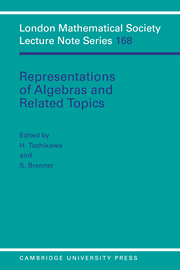Book contents
- Frontmatter
- Contents
- Introduction
- Homologically finite subcategories
- Global generatedness version of rings of pure global dimension zero
- Projective resolutions and degree shifting
- Modules of finite length over their endomorphism rings
- Pairs of semi-simple algebras (hereditary algebras with radical-square zero)
- The module theoretical approach to quasi-hereditary algebras
- Matrix problems, small reduction and representations of a class of mixed Lie groups
- Classification problems for modular group representations
- Lie algebras (arising in representation theory)
Homologically finite subcategories
Published online by Cambridge University Press: 05 August 2013
- Frontmatter
- Contents
- Introduction
- Homologically finite subcategories
- Global generatedness version of rings of pure global dimension zero
- Projective resolutions and degree shifting
- Modules of finite length over their endomorphism rings
- Pairs of semi-simple algebras (hereditary algebras with radical-square zero)
- The module theoretical approach to quasi-hereditary algebras
- Matrix problems, small reduction and representations of a class of mixed Lie groups
- Classification problems for modular group representations
- Lie algebras (arising in representation theory)
Summary
Let Λ be an artin algebra and modΛ the category of finitely generated A–modules. Unless stated to the contrary, by a subcategory C of a category we mean a full subcategory of an additive category, for example modΛ, closed under isomorphisms and direct summands. About ten years ago, in connection with proving the existence of preprojective and preinjective partitions for modΛ as well as the existence of almost split sequences in certain subcategories of modΛ, Auslander and Smalø introduced the notions of contravariantly, covariantly and functorially finite subcategories of modΛ and developed some of their basic properties [5] [6]. We refer to the study of these subcategories as the theory of homologically finite subcategories. At the time Auslander and Smalø pointed out that there is an intimate connection between the tilting theory of Happel and Ringel based on tilting modules of projective dimension at most one and the theory of homologically finite subcategories [6]. Utilizing recent developments in the theory, we have now given precise connections between the tilting theory developed by Miayshita and Happel based on tilting modules of arbitrary finite projective dimension and the theory of homologically finite subcategories in [4]. Inspired by this new point of view on tilting theory, Ringel has shown that associated with a quasihereditary algebra Λ and a particular type of ordering of its simple modules is a naturally defined tilting module whose endomorphism ring is again quasihereditary. It follows from this that quasihereditary algebras occur in pairs [13].
- Type
- Chapter
- Information
- Representations of Algebras and Related Topics , pp. 1 - 42Publisher: Cambridge University PressPrint publication year: 1992
- 8
- Cited by



